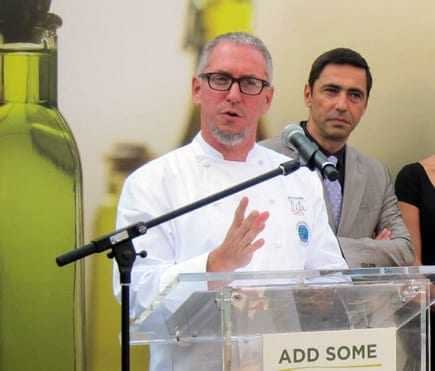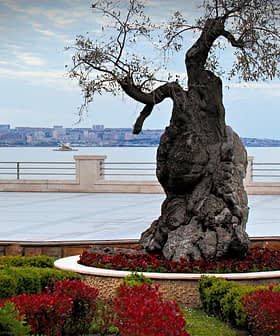
It may not be much to work with, but with a $1.7 million dollar allowance from the International Olive Council, the people running the new “Add Some Life” promotional campaign hope to at least make eating olive oil a little cooler.
So in a thinly attended “press event” loosely associated (i.e. in the same city) with the Mercedes Benz Fashion Week in New York, PR types mixed EVOO cocktails Monday and invited Americans to see olive oil as fashionable.
First-year IOC executive director Jean-Louis Barjol, making his third trip here since starting his job last January, has deemed the United States a “top priority” for his agency’s promotional efforts. But while Barjol called the current budget merely “a beginning,” he must have wondered what effect a small gathering of food bloggers behind Lincoln Center might ultimately have on the olive oil consumption habits of 450 million North Americans.
With a culinary presentation by a trade show-ready restaurateur from Miami, Michael Schwartz, and an olive oil drink-maker named Ryan Goodspeed who, with his 6 Twitter followers, almost seemed to have been created especially for the event, early signals that a well-known “celebrity chef” might be charged with popularizing olive oil in McDonalds Country hit a reality checkpoint in New York.
Still, the gathering marked the international agency’s first promotional foray into the American market in over ten years, and any effort here is much-needed good news for the world’s producers weary from years of historically weak olive oil prices and formidable challenges.
In proposing a link between olive oil and high-fashion, campaign organizers seem to be hoping they can set a viral spark among influencers instead of chipping away at the average American’s utter confusion about olive oil and its practical applications.
And while establishing the perceived value of olive oil by highligting its unrivaled sensory qualities has been an industry meeting point lately in places like New York and Córdoba, most potential consumers are far from Lincoln Center, and even farther from understanding the relevance of Fashion Week to their daily diets.
Flanked by A‑list EVOO merchants like Zabars, Fairway Market, and Dean and Deluca, New Yorkers on the Upper West Side already use a lot of olive oil and undoubtedly know more about it than anyone clear to Davis, California. But fanning out to Wal Marts in Middle America can burn through $1.7 million pretty fast, even if it might ultimately result in greater understanding, appreciation, and consumption of such an important food.
But like the new olive oil shops popping up in tourist trap locations dispensing decorative bottles of no-name EVOO for 90 dollars per liter like exotic curiosities, the Olive Council’s catwalk Monday seemed to send yet another confusing message at a time when simplicity and real value might out-resonate aspirational themes.








